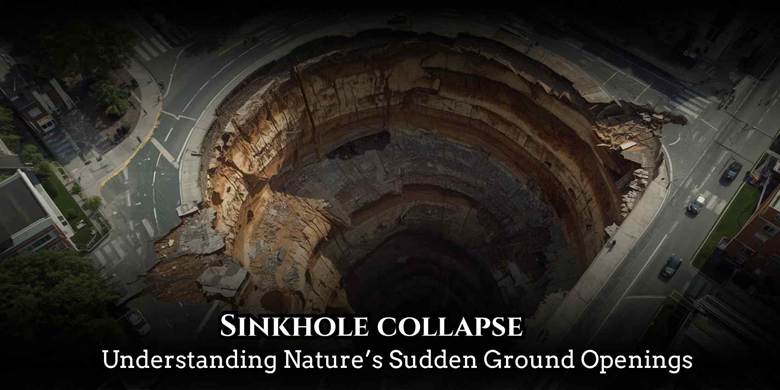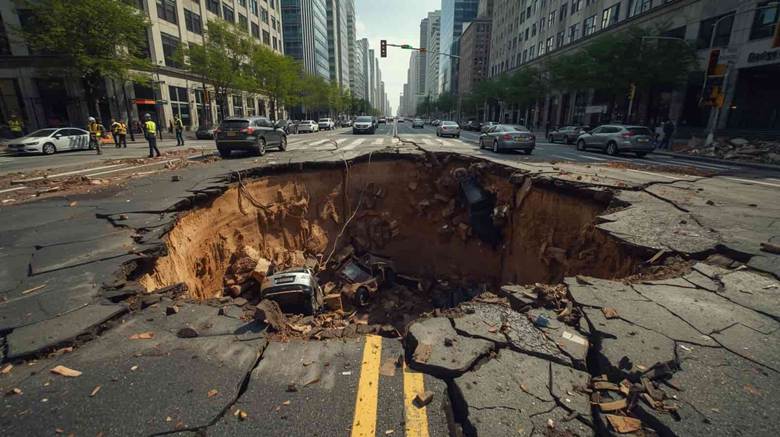When the earth suddenly caves in, creating a massive hole that swallows everything above, it’s known as a sinkhole collapse one of nature’s most dramatic and unpredictable events. These ground failures can occur in both rural and urban areas, often without warning, leaving behind striking landscapes and serious hazards. Caused by the gradual erosion of underground rock, particularly limestone, they reveal the hidden processes shaping our planet’s surface.
Table of Contents
In this article, we’ll explore how sinkholes form, what triggers their collapse, and how groundwater erosion, karst topography, and soil stability all play crucial roles in their development and prevention.

Understanding Sinkhole Collapse and Its Impact on the Earth
A sinkhole collapse is a fascinating yet destructive geological process where the ground suddenly gives way, forming a deep, circular depression. These natural events remind us that the Earth’s surface is constantly changing, often due to hidden processes beneath our feet. Understanding why and how sinkholes form is crucial for predicting and preventing potential damage, especially in regions built over soluble rocks like limestone or gypsum.
What is a Sinkhole?
A sinkhole is a natural depression or cavity in the ground that occurs when the surface layer collapses into an underground void. Most sinkholes form gradually through the dissolution of soluble rock, but in some cases, the surface can suddenly give way, leading to a catastrophic sinkhole collapse.
Main Types of Sinkholes
- Solution Sinkholes – Created by the slow erosion of rock through water seepage.
- Cover-Subsidence Sinkholes – Form when soil gradually sinks into small underground cavities.
- Cover-Collapse Sinkholes – Develop rapidly when a large cavity causes the ground to suddenly cave in.
The Geological Background
Sinkholes often form in karst landscapes where soluble rocks like limestone or gypsum dissolve as acidic rainwater seeps underground, creating hidden voids. When these spaces grow too large, the surface collapses. Historically seen in regions like China, Mexico, and Florida, such events have become more common today due to human activities like over-pumping groundwater, mining, and urban development.
Causes and Triggers of Sinkhole Collapse
Several natural and human-induced factors can trigger sinkhole formation and collapse.
Natural Causes
- Groundwater Erosion – Continuous movement of water dissolves subsurface rock.
- Heavy Rainfall or Flooding – Saturated soil increases pressure on underground voids.
- Drought – When water levels drop, previously supported ground layers lose stability.
Human Activities
- Overpumping Groundwater – Depletes underground support and accelerates void formation.
- Construction and Urbanization – Alters natural drainage and increases surface load.
- Mining and Drilling – Disturbs underground rock layers and increases collapse risks.
These triggers combine to weaken the structural integrity of the land, making sinkhole collapse more likely in vulnerable regions.
Why Understanding Sinkhole Collapse Matters
The study of sinkholes goes beyond geology; it has real-world applications in public safety, land management, and environmental conservation.
1. Safety and Risk Management
Knowing how sinkholes form helps governments and engineers identify high-risk zones. By using ground-penetrating radar and geophysical mapping, authorities can detect voids before they collapse.
2. Infrastructure Protection
Cities and towns built on karst terrains rely on continuous monitoring to protect roads, pipelines, and buildings from ground failure. Preventing sinkhole collapse minimizes costly repairs and property damage.
3. Environmental Insights
Sinkholes also provide scientists with access to unique ecosystems and underground water channels. Studying them improves our understanding of groundwater flow, aquifer recharge, and soil composition.
Benefits of Studying Sinkholes
Although destructive, studying these natural features offers several benefits:
- Enhances knowledge of subsurface geology
- Improves methods for disaster preparedness
- Aids in land-use planning and urban safety
- Supports better water resource management
- Encourages public awareness of natural hazards
These benefits demonstrate that understanding the dynamics of a sinkhole collapse contributes to both scientific advancement and community resilience.
Challenges in Monitoring and Prevention
Despite technological progress, predicting sinkholes remains a major challenge.
1. Hidden Nature of Underground Cavities
Subsurface voids are often invisible until collapse occurs. Ground surveys and radar imaging can help, but they are costly and time-consuming.
2. Human Influence
Urban expansion and over-extraction of groundwater accelerate sinkhole formation, especially in heavily populated regions. Striking a balance between development and geological stability remains a complex issue.
3. Climate Change Effects
Shifts in rainfall patterns and rising sea levels can alter groundwater behavior, increasing the risk of sinkhole collapse in coastal and arid zones.
Real-World Examples
Several dramatic examples of sinkhole collapse around the world highlight the immense power of this natural phenomenon.
- Guatemala City, 2010: A massive sinkhole swallowed several buildings after heavy rainfall and sewage leaks.
- Florida, USA: Known as the “Sinkhole Capital of the World,” Florida frequently experiences collapses due to its limestone foundation.
- China’s Xiaozhai Tiankeng: One of the world’s largest sinkholes, formed naturally over centuries through erosion and groundwater movement.

These examples emphasize that sinkhole collapse can occur anywhere, from urban centers to remote karst landscapes.
Future Outlook and Prevention Strategies
To reduce the dangers of sinkhole collapse, scientists now use satellite monitoring, remote sensing, and AI models to detect risks early. Public awareness also helps communities spot warning signs like cracks or sudden ground shifts.
Conclusion
The sinkhole collapse phenomenon reminds us of the hidden power beneath the Earth’s surface. Understanding how these collapses form, what triggers them, and how they affect our environment is essential for safety, sustainable development, and scientific progress. By studying their causes and improving monitoring systems, we can reduce damage and protect communities living in high-risk areas. To stay safe and informed, continue to learn more, stay updated, and explore further into the fascinating world of geological change and land stability.